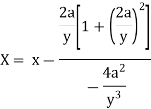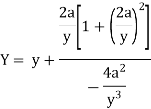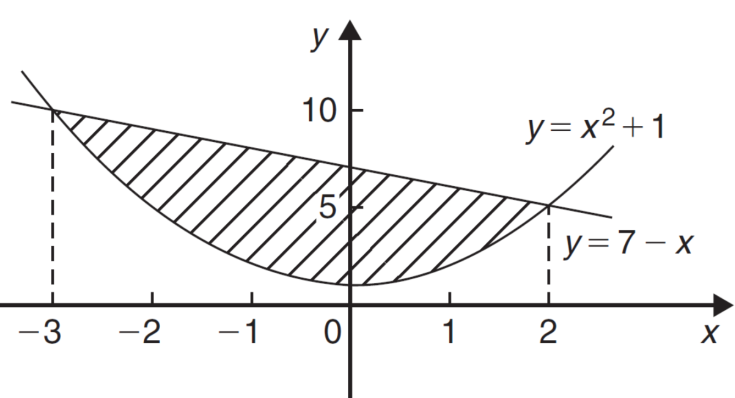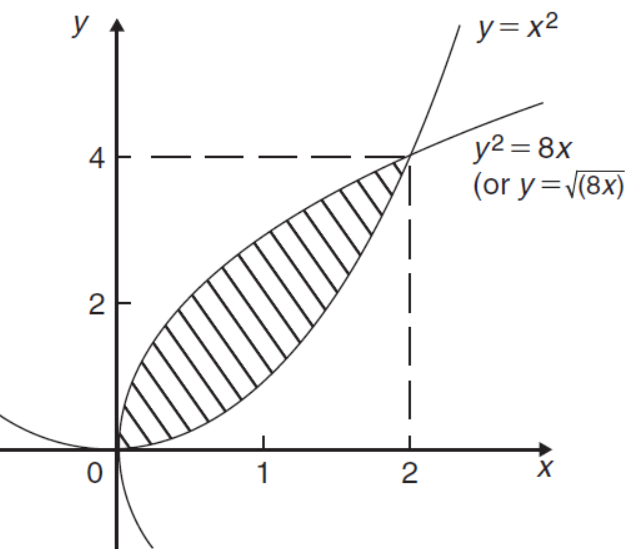Unit – 1
Calculus
Q1) Prove that the evolute of parabola  is given by
is given by 
A1) It is given that-

If (X, Y) are the coordinates of the centre of curvature at any point P (x, y) on the curve y = f(x), then X and Y are given as-
 …………….. (1)
…………….. (1)
Now consider the equation of parabola (given)

On differentiating w.r.t x-

Again differentiating w.r.t. x-

Put these derivatives in (1), we get-

Now consider X,





Here we get-

Now consider,





Here we get-

Now
Taking L.H.S of 

Taking R.H.S of 

Hence proved.
Q2) Evaluate .
.
A2) Here we notice that f:x→cos x is a decreasing function on [a, b],
Therefore, by the definition of the definite integrals-

Then

Now,





Here 
Thus


Q3) Evaluate 
A3) Here  is an increasing function on [1, 2]
is an increasing function on [1, 2]
So that,



 …. (1)
…. (1)
We know that-


And

Then equation (1) becomes-



Q4) Evaluate dx
dx
A4) dx =
dx =  dx
dx
= Γ (5/2)
= Γ (3/2+ 1)
= 3/2 Γ (3/2)
= 3/2. ½ Γ (½)
= 3/2. ½ π
= ¾ π
Q5) Evaluate  dx.
dx.
A5) Let 
 dx.
dx.
x | 0 |  |
t | 0 |  |
Put  or
or  ; 4x dx = dt
; 4x dx = dt
 dx
dx




Q6) Determine the area enclosed by the curves-

A6) We know that the curves are equal at the points of interaction, thus equating the values of y of each curve-

Which gives-

By factorization,

Which means,
x = 2 and x = -3
By determining the intersection points the range the values of x have been found-
x | -3 | -2 | -1 | 0 | 1 | 2 |
 | 10 | 5 | 2 | 1 | 2 | 5 |
And
x | -3 | 0 | 2 |
y = 7 - x | 10 | 7 | 5 |
We get the following figure by using above two tables-

Area of shaded region = 

= 

= (12 – 2 – 8/3) – (-18 – 9/2 + 9)
= 
= 125/6 square unit
Q7) Find the area enclosed by the curves  and if the area is rotated
and if the area is rotated  about the x-axis, then determine the volume of the solid of revolution.
about the x-axis, then determine the volume of the solid of revolution.
A7) We know that, at the point of intersection the coordinates of the curve are equal. So that first we will find the point of intersection-



We get,
x = 0 and x = 2
The curve of the given equations will look like as follows-

Then,
The area of the shaded region will be-
A = 
So that the area will be 8/3 square unit.
The volume will be
= (volume produced by revolving  – (volume produced by revolving
– (volume produced by revolving 
= 
Q8) Find the volume of the solid of revolution formed by revolving R around y-axis of the function f(x) = 1/x over the interval [1, 3].
A8) The graph of the function f(x) = 1/x will look like-

The volume of the solid of revolution generated by revolving R (violet region) about the y-axis over the interval [1, 3]
Then the volume of the solid will be-


Q9) Verify Rolle’s theorem for the function f(x) = x2 for 
A9)
Here f(x) = x2; 
i) Since f(x) is algebraic polynomial which is continuous in [-1, 1]
ii) Consider f(x) = x2
Diff. w.r.t. x we get
f'(x) = 2x
Clearly f’(x) exists in (-1, 1) and does not become infinite.
iii) Clearly
f (-1) = (-1)2 = 1
f (1) = (1)2 = 1
 f (-1) = f (1).
f (-1) = f (1).
Hence by Rolle’s theorem, there exist  such that
such that
f’(c) = 0
i.e., 2c = 0
 c = 0
c = 0
Thus  such that
such that
f'(c) = 0
Hence Rolle’s Theorem is verified.
Q10) Verify whether Rolle’s theorem is applicable or not for

A10)
Here f(x) = x2; 
i) X2 is an algebraic polynomial hence it is continuous in [2, 3]
ii) Consider


F’(x) exists for each 
iii) Consider


Thus  .
.
Thus, all conditions of Rolle’s theorem are not satisfied Hence Rolle’s theorem is not applicable for f(x) = x2 in [2, 3]
Q11) Verify the Lagrange’s mean value theorem for

A11)
Here 
i) Clearly f(x) = log x is logarithmic function. Hence it is continuous in [1, e]
ii) Consider f(x) = log x.
Diff. w.r.t. x we get,

Clearly f’(x) exists for each value of  & is finite.
& is finite.
Hence all conditions of LMVT are satisfied Hence at least 
Such that

i.e., 
i.e., 
i.e., 
i.e., 
since e = 2.7183

Clearly c = 1.7183 
Hence LMVT is verified.
Q12) Verify Cauchy mean value theorems for  &
& in
in 
A12)
Let  &
& ;
; 
i) Clearly f(x) and g(x) both are trigonometric functions. Hence continuous in 
ii) Since  &
&
Diff. w.r.t. x we get,
 &
&
Clearly both f’(x) and g’(x) exist & finite in  . Hence f(x) and g(x) are derivable in
. Hence f(x) and g(x) are derivable in  and
and
iii) 

Hence by Cauchy mean value theorem, there exist at least  such that
such that

i.e., 

i.e., 1 = cot c

i.e., 
Clearly
Hence Cauchy mean value theorem is verified.
Q13) Using Taylors series method expand
 in powers of (x + 2)
in powers of (x + 2)
A13)
Here 
a = -2
 By Taylors series,
By Taylors series,
 … (1)
… (1)
Since









 ,
,  , …..
, …..
Thus equation (1) becomes


Q14) Evaluate 
A14) Let f(x) =  , then
, then

And
 = 0
= 0
 = 0
= 0
But if we use L’Hospital rule again, then we get-

Q15) Find out the maxima and minima of the function

A15) Given  …(i)
…(i)
Partially differentiating (i) with respect to x we get
 ….(ii)
….(ii)
Partially differentiating (i) with respect to y we get
 ….(iii)
….(iii)
Now, form the equations 
Using (ii) and (iii) we get


 using above two equations
using above two equations
Squaring both side we get

Or 
This show that 
Also, we get 
Thus, we get the pair of value as 
Now, we calculate



Putting above values in

At point (0,0) we get

So, the point (0,0) is a saddle point.
At point  we get
we get

So, the point  is the minimum point where
is the minimum point where 
In case 

So, the point  is the maximum point where
is the maximum point where 